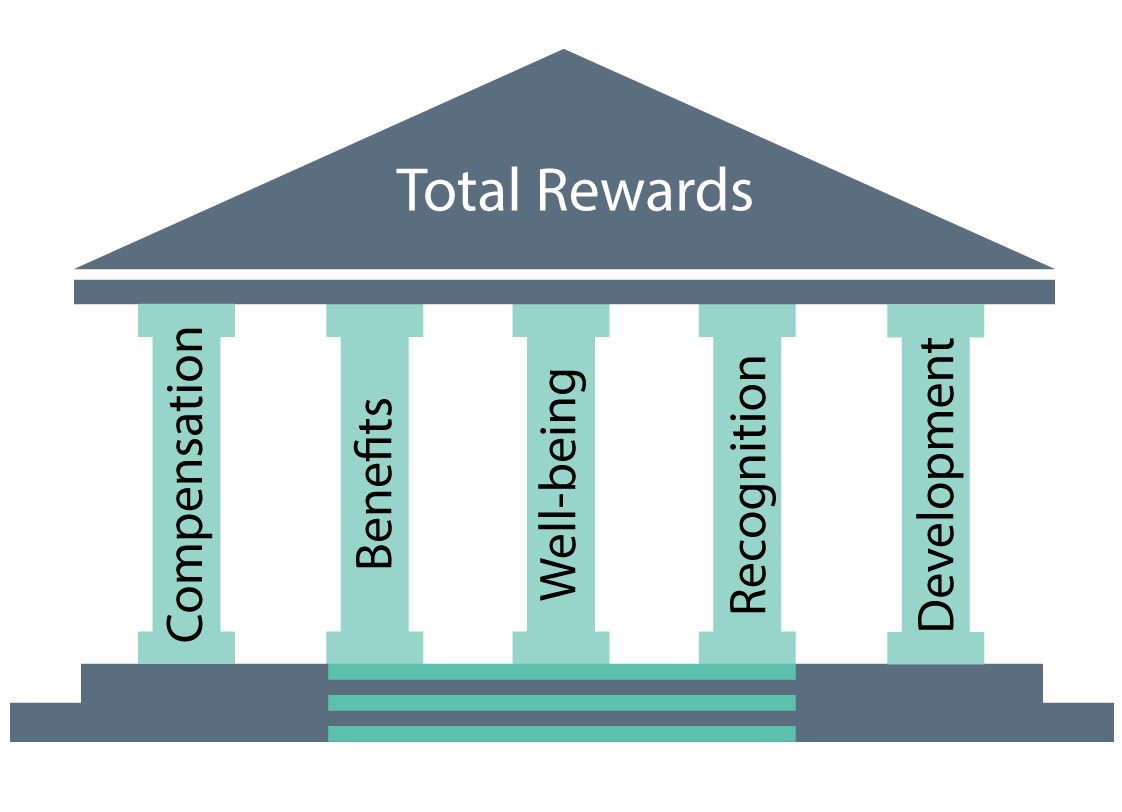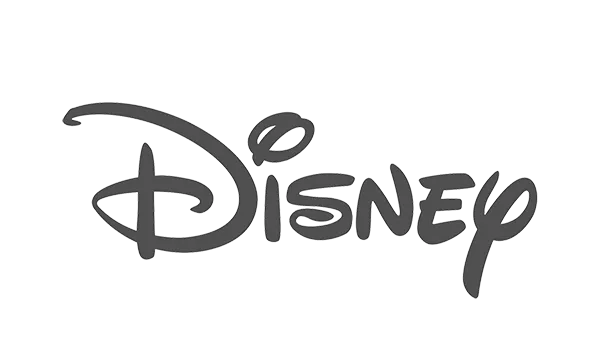Modern employers are increasingly aware of their employees’ needs in and outside of the workplace. As a result, these employers like to get creative when it comes to employee compensation and the value proposition they offer potential hires.
With a total rewards strategy, compensation can take any number of forms, including increased PTO, stock options, career development programs, and many other employee benefits and perks.
What is a Total Rewards Strategy?
An effective total rewards strategy introduces various monetary and non-monetary benefits, incentives, and amenities to the workplace. It’s not meant as a replacement for traditional pay or benefits. Instead, it’s a strategy that expands on an employee’s fair compensation with additional incentives that are meant to encourage performance.
While organizations have varying ideas regarding what kind of benefits to offer, the general concept of a total rewards strategy is based on key elements. These include basic remuneration, wellness and other benefits (such as health insurance), financial incentives, non-monetary rewards, paid time off or flexible work to maintain work-life balance, opportunities for career advancement, and so forth. These can all be divided into five buckets.
The Five Components of a Total Rewards Strategy
Five core elements, often known as pillars, build the basic foundation of the total rewards concept. These consist of:
- The compensation or remuneration of each employee
- The benefits packages offered by the organization
- Overall work-life balance
- Employee recognition, and
- Career development
The tangible and intangible rewards that make up each pillar are, for the most part, up to the organization, the human resources team, and the employees themselves.

Compensation / Remuneration
The first pillar of the total rewards strategy focuses on the total compensation package, or remuneration, of employees. Base pay or salary is included, but it’s far from being the only form of employee compensation available. Other possible financial rewards include (but are not limited to):
- Goal- or performance-based incentives, including spot bonuses
- Commissions or other forms of variable pay
- Holiday cash bonuses
- Stock options
- Profit sharing
Many of the options here are dependent on your organization’s structure or general industry.
Offering employees stock options, for example, might not be a feasible solution for a startup. Like the other pillars of the total rewards strategy, the trick is to find a compensation program that works best for the company and the staff.
Benefits
Employee benefits are a major part of the total rewards strategy. When considering benefits, most employees immediately think of healthcare and other forms of benefits insurance, which typically include:
- Dental insurance
- Vision
- Life cover
- Disability cover
However, an employee benefits package can include much more than insurance.
Local gym memberships, for example, help promote health and wellness among the workforce. Access to company vehicles or compensation for public transportation can go a long way in offsetting the average cost of living for many employees. Other popular benefits include:
- Vacation time and other types of PTO
- Paid luncheons
- Retirement plans
The key difference between employee benefits and perks is that a benefit is a contractual obligation on the employer’s part for the length of employment. It is part of what the employee becomes entitled to or has access to by doing their job.
Many benefits are granted in addition to an employee’s base pay or salary, but some require a weekly or monthly fee subsidized by the employer. The amount payable by the employee is usually automatically deducted from their paycheck.
Well-Being / Work-Life Balance
Organizations have made huge improvements in the work-life balance of their employees ever since the COVID-19 pandemic. This is no small feat.
Since employees have different needs, objectives, and ideas on what constitutes a healthy work-life balance, team leaders and managers need to be extra diligent – and extra receptive – to the feedback of their staff. Some potential options include:
- Employee assistance programs (EAPs)
- Resource groups
- DEI (Diversity, Equity, Inclusion) classes
- Community volunteerism
- Options for remote work
- Flexibility in work schedules and work environment
Employee Recognition
Who doesn’t want to be recognized for a job well done?
Depending on your organization, employee recognition programs may take on many different forms. Some employers distribute employee awards, with some going so far as to host elaborate award ceremonies. Others take a low-key approach by recognizing individual contributions in private, one-on-one meetings.
Employee recognition comes in am forms and has proven to be a key driver in employee satisfaction, employee engagement, and retention.
Career Development
It’s always a good idea for organizations to invest in their top talent. One of the best ways to maximize the return on that investment is by supporting various career development initiatives. There are numerous career development opportunities you can make available to employees, regardless of their industry, including:
- Skills training
- Job coaching or mentorship
- College degree programs
- Career guidance
Skills developed benefit your employees in the long run. But, when synchronized with their day-to-day responsibilities in the workplace, a continuously improved workforce also strengthens the company’s bottom line.
The Link Between Total Rewards and Employee Satisfaction
Only 34% of U.S. workers are satisfied with their current pay. While a slightly higher portion – 49% – are happy with the benefits they get, employers who implement a total rewards strategy will likely drive these numbers even higher.
Various studies throughout the years have built direct links between employee satisfaction and all five pillars of the total rewards package. According to The Conference Board’s Job Satisfaction 2023 survey, the employee satisfaction of U.S. workers climbed to 62.3%, an all-time high since the organization started tracking employee satisfaction in 1987.
Per the report, some of the biggest leaps were seen in elements like work-life balance, day-to-day workloads, and employee performance appraisals – all of which play large roles in the total rewards framework. Some other key takeaways from the survey include:
- Male workers tend to be more satisfied with their jobs than their female counterparts.
- Hybrid workers report greater levels of employee satisfaction than on-premise or remote workers.
- Those who have started a new job recently tend to report higher levels of satisfaction with their employee experience.
- Some of the most important factors in overall job satisfaction include the quality of leadership staff, company culture, and work-life balance.
The Conference Board’s survey also highlights some key factors that influence employee retention, which include competitive pay and benefits programs, company culture, and day-to-day experiences in the workplace.
Gallup also suggests a direct correlation between workplace productivity and employee well-being. By investing in employee health, both mental and physical, and ensuring a proper work-life balance, most organizations should be able to maintain acceptable productivity levels. Some highlights from the recent Gallup study include:
- Turnover and the resulting loss of business performance costs global employers approximately $322 billion on an annual basis.
- Employees who feel engaged but aren’t thriving in the workplace report a 61% higher rate of burnout than those who are both engaged and thriving.
- Only 25% of U.S. employees believe that their employer cares about their well-being.
- A company culture that promotes high employee engagement often minimizes new cases of depression and anxiety in the workplace.
By maintaining an emphasis on the total rewards strategy, organizational leaders can drive employee engagement and productivity to all-new heights. However, the total rewards framework doesn’t run itself. To maximize the results, it’s best to follow a few foundational best practices.
Total Rewards Strategy Best Practices
Organizations need to take a hands-on approach to the creation, implementation, and maintenance of the total rewards strategy to ensure they include components employees value most. Those who take the set-it-and-forget-it approach will seldom receive the results they are looking for, so it’s vital to follow a few best practices.
- Analyze your current pay structure and benefits package while highlighting strengths and weaknesses.
- Identify and prioritize business goals and what your company hopes to achieve with the total rewards strategy.
- Utilize online compensation benchmarks and labor market trends to ensure your company is offering competitive salaries for your industry and location.
- Collect employee feedback and adjust the total rewards strategy to offer benefits that your employees want and need.
- Track the costs of your strategy to ensure a positive return on investment.
- Ensure your total rewards strategy benefits all demographics represented in your team.
- Communicate with your employees to ensure their awareness of benefits and update them whenever changes occur.
- Ensure your company culture, mission statement, and values are all in alignment with your total rewards strategy.
FAQs (Frequently Asked Questions) about Total Rewards
While the general concept is pretty straightforward, the nuances of the total rewards strategy often leave managers and employees with some uncertainties. The questions – and answers – listed below provide more insight into the total rewards framework.
What Is the Main Goal of a Total Rewards Strategy?
Although each organization has its own goals regarding its strategy, the main objective of most total rewards strategies is to encourage employee satisfaction, engagement, and retention.
This is achieved when an employer offers a holistic mixture of non-monetary and monetary rewards, professional development programs, and employee recognition initiatives.
How Can Small Businesses Implement Total Rewards Strategies?
Thankfully, the total rewards strategy is a scalable platform that can be scaled up or down to meet the needs of nearly any organization.
While remuneration and other monetary benefits are highly motivational, small businesses should focus more on team- and community-driven rewards when trying to make up for a lack of capital. There are also no restrictions to company size when it comes to the validity of wellness program initiatives, employee recognition programs, or employee development and training.
Can Total Rewards Be Adapted for Remote Workforces?
Yes! The total rewards strategy is a versatile framework that can easily be applied to remote and hybrid workplaces.
In cases like this, it’s crucial to offer localized reward models that are pertinent to their city, state, or country. Since the cost of living varies so greatly between locations, it’s often difficult to create a strategy that treats everyone fairly – but it can be done.
What Are the Key Metrics for Measuring Total Rewards Strategy Success?
There are numerous ways you can measure the success of your total rewards program.
Retention and employee engagement metrics are indicative of success. These include employee turnover (both on a company level and departmentally), staffing levels, employee job satisfaction, individual career growth, and average employee tenure with the company. For best results, make sure to document these numbers before implementing your strategy and at regular intervals moving forward. This will make it much easier to disseminate the actual results.
Common Pitfalls to Avoid in Total Rewards Strategy Implementation
When implemented correctly, a total rewards strategy will benefit your entire organization. There are some common pitfalls to avoid that, if left unchecked, could become major obstacles to the success and efficiency of your entire strategy.
High Program Costs
Although it’s tempting to fill your total rewards strategy with monetary bonuses, gift cards, and paid luncheons for every employee, you need to be realistic with your spending and stay within budget.
If you find that your program still comes up short, try to fill the gaps with elements that don’t affect your organization’s profitability – like extra vacation time, the option to work from home, or training courses.
Distributing Rewards Based on Performance Alone
While it’s nice to reward employees for superior performance, the best total rewards strategies don’t reward staff based on employee performance alone.
Other factors, such as their attitude, their ability to work with teammates, and their willingness to learn should be taken into account.
Over Competitiveness
A little bit of healthy competition amongst employees can be a good thing, but don’t let it grow out of control. Remember, one of the purposes of the total reward strategy is to encourage teamwork.
If you find that staff members are constantly bickering or trying to one-up each other, it might be time to re-evaluate the strategy and consider a different approach. Rewards should only incentivize behaviors that benefit the company.
Employee Entitlement
Rewards can cause certain employees to feel a sense of entitlement. Since they’ve received rewards and recognition in the past, they might start to expect them every time in the future.
In cases like this, employees are actually discouraged from performing their best unless a clear reward is offered, which can cause the overall quality of their work to decline.
Last Thoughts: Making the Total Rewards Strategy Work for You
Your total rewards strategy needs to be a viable program that works for your organization while providing real benefits that your workforce can use.
While you can look at brands and companies for inspiration, you’ll ultimately want to look toward your employees for feedback once your total rewards strategy is up and running. Most will be happy to share their thoughts and express their likes (or dislikes) about the benefits they’re receiving to help you achieve a beneficial and holistic approach to rewards.




















